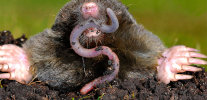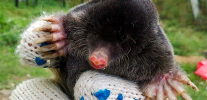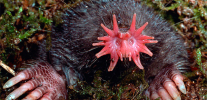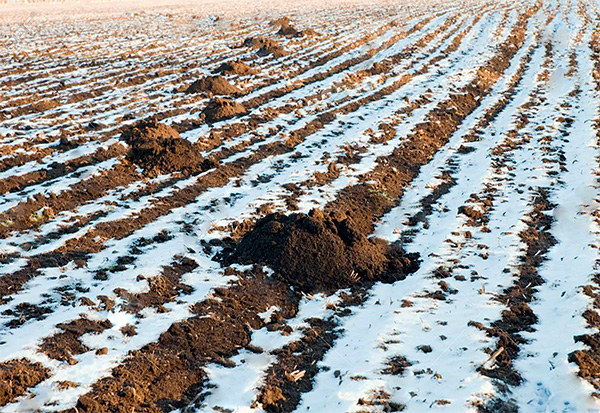
Next you will learn:
- Do moles fall into hibernation like many other animals, or is it a myth;
- How moles hibernate, and what helps them survive the cold season;
- Do moles make food supplies for the winter and do they continue to dig ground under the snow in search of new food;
- Is it worth it to leave protection against moles on the site for the winter, or does it not make sense.
... And also a number of other interesting nuances regarding the features of mole wintering.
Winter for moles is a very difficult period - in the cold season, these animals have to mobilize all their resources in order to survive, so they carefully prepare for wintering. However, even in spite of this, in some years many moles perish, never surviving until spring.
For many gardeners and owners of a summer cottage, the question of how the mole hibernates has a lot of practical significance, allowing us to competently organize the protection of a garden or a resting garden from these animals - we will also talk about this a little lower.
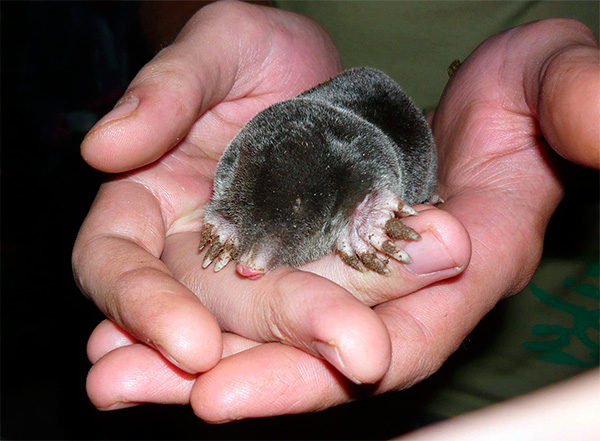
But for starters, let's see if the mole sleeps in the winter, or does it continue to actively dig moves and eat, without hibernating? ..
Do moles hibernate?
In winter, the mole does not hibernate. Generally speaking, the myth that the mole hibernates in the winter formed for the following reasons:
- By winter, the crop has already been harvested, and there is no way to see potato tubers damaged by the paws of a mole, or beets and carrots. Accordingly, gardeners no longer swear every day due to shoveling beds, and believe that moles "from lack of food" can only go into hibernation (surprisingly, the myth that moles feed on vegetables and grass is very common, although in reality these animals are predators);
- In winter, under the snow, often there are no signs of the mole's life (as opposed to summer, when heaps of land throughout the site eloquently speak of active labor by underground diggers). As a result, a misleading impression is created that these animals are not active at all in the winter. Well, if they are not active, it means they are sleeping;
- People who know well that the mole feeds mainly on worms and insects are sure that the animal cannot find food for itself in winter, and, accordingly, the only way out for it is to hibernate. Meanwhile, everything is not so simple, and even in winter moles quite actively dig moves and continue to eat ...
The photo below shows fresh molehills under the snow:
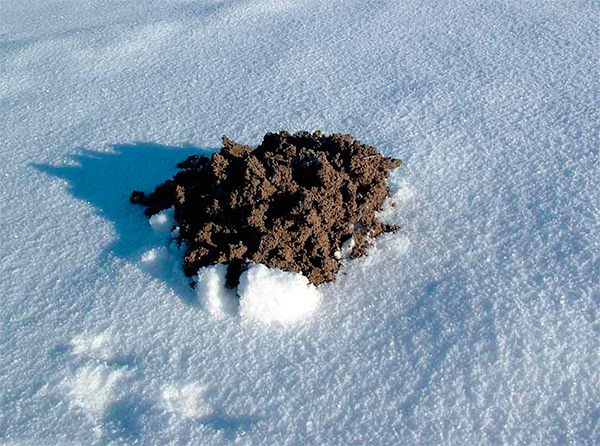
It is worth noting that in moles, due to a very fast metabolism, energy reserves in the body are consumed rapidly, and these animals simply will not survive a long period of time without food.
On a note
In summer, the mole dies if it does not find food for itself within 15-17 hours. In winter, his metabolism slows down somewhat, and in the presence of a fat reserve, the animal can stretch up to one and a half days, but no more.
Shrews hibernate like moles - they are also small, very voracious and forced to remain active all year round.
An inquisitive reader may ask: why, for example, a hedgehog hibernates, but a mole does not. After all, the hedgehog is also an insectivorous animal. To understand this, you need to take into account some interesting nuances of the mole’s winter lifestyle, which we will do ...
How the mole winters and what it does in the cold season
First of all, remember that the mole is an animal that leads mainly an underground way of life. In the warm season, he sometimes gets out of the dungeon through molehills, in winter, even having made his way to the surface of the earth, he usually remains in the snow (he rarely crawls out from under it - see the example in the photo below).
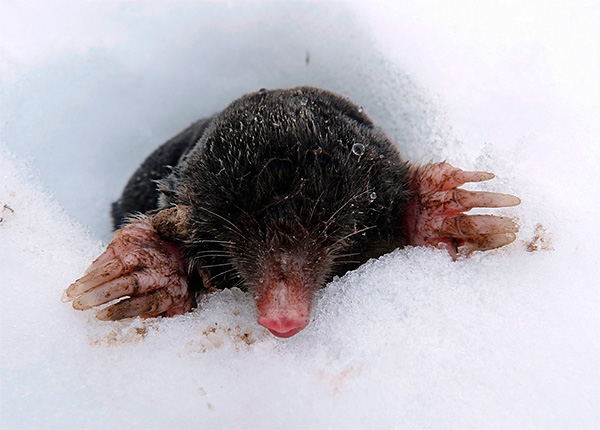
Under a layer of snow and earth, even at a relatively shallow depth, it will be noticeably warmer than on an open wind surface of the snow. This means that the heat loss of the underground resident will be less than that of animals living on the surface of the earth. The same, for example, the hedgehog will mercilessly freeze in the winter, while in the underground passages of the mole the air is much warmer than outside. This helps a lot to survive moles even very cold winters.
Moles winter in the same areas where they spend summer. Just like in the summer, they periodically dig out passages, actively move along them and continue to spend days constantly searching for prey, including collecting those worms that were left here in reserve on days of plenty. As in the warm season, after saturation, the animal returns to one of several expanded chambers in which it rests.
Sometimes in winter, the mole makes moves under the snow, on the very surface of the soil through the leaf cover. This can be rational, since it is under the leaves that a large number of insects and their larvae winter, which the animal can profit from, winters.
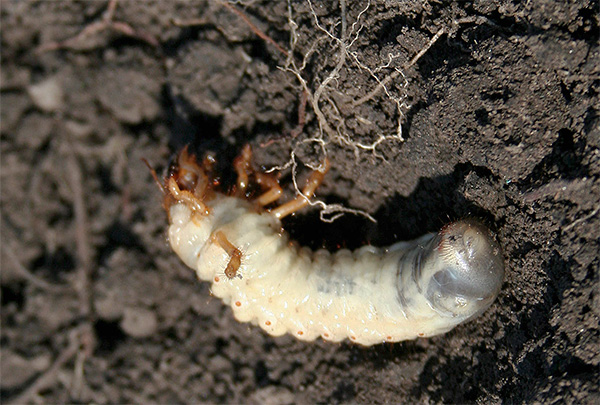
Moles dig passages in the winter in the snow itself, thereby forming vents for their ramified system of underground tunnels.
In winter, moles live at almost the same depth as in summer. This is due to the specifics of creating the passages themselves: at a depth of more than half a meter, they can no longer lift a layer of dense soil above themselves, and each portion of the dug up soil has to be pushed back with its hind legs towards the molehill, lifted to the surface and thrown out. If at a depth of up to half a meter the animal is still somehow able to do this titanic work, then from a greater depth it is already problematic to raise the earth (it is energetically disadvantageous). Only in rare places do moles arrange their nesting chambers to a depth of 1 meter.
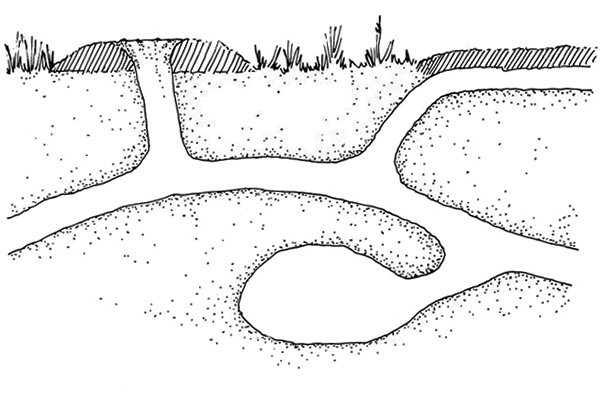
The main number of mole hunting trips in winter is at a depth of 5-10 cm below the soil surface. In fact, the mole also hibernates at this depth, spending most of the time here, and only several times a day climbing into the deeper sections of the passages for sleeping and resting.
In years with frosty and snowy winters, the soil freezes at this depth, it becomes more difficult to find food, and laying new passages further depletes the animal. Moles in such winters often die en masse from mass-feeding.
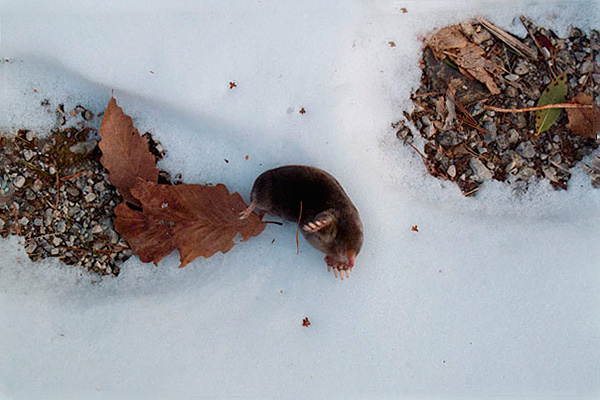
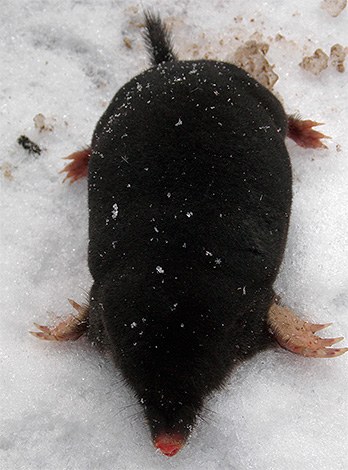
On a note
But the mole’s frost is not terrible. Partly due to warm fur, partly due to the lack of wind and lower temperature drops in the underground passages. The main enemy of the animal in winter is hunger.
Mole feeding in winter
The winter diet of the mole as a whole differs little from the summer: still the lion's share of it is made up of earthworms, to a lesser extent - insects and their larvae, which can be found under fallen leaves, among the roots of plants or in the passages themselves. If a weakened mouse runs into an underground tunnel and becomes a dead end, then an insatiable predator can eat it too.
Basically, food sources in winter are much less abundant than in summer - insects winter almost without movement, and in order to find their mole, they themselves have to constantly lay new passages, rake foliage under the snow and expand the search area.
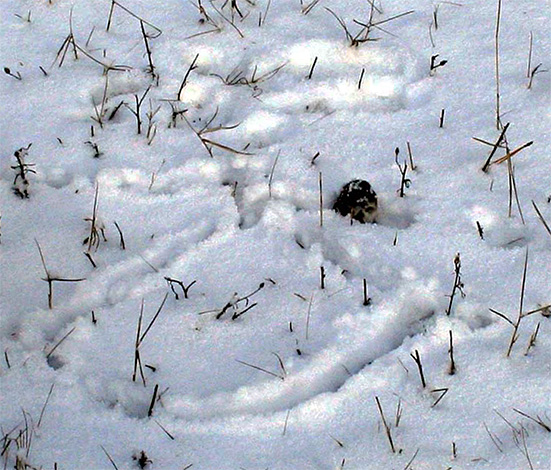
It is interesting
In the summer, the smell of the mole helps to feed the mole. Earthworms have a positive chemotaxis to the “delicate” aroma of musk, which is saturated with all the moves of the animal, that is, they crawl onto it. As a result, the worms “fall out” into the mole's moves, and he regularly collects such readily available food that literally goes into his mouth.
The mole also makes reserves for the winter. Almost 100% they consist of worms, which the animal with a "surgical" bite damages the nerve nodes or bites off the head (more precisely, the front part). The idea that if an earthworm is cut into two parts, it turns out two viable halves, is incorrect - only the front part is capable of regeneration, and the back always dies.
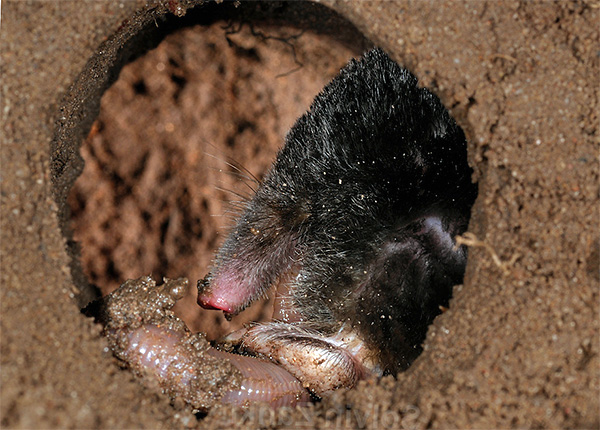
Worms prepared in this way can simply lie along the entire system of underground passages, and sometimes the animal stores stocks in special chambers.
Scientists who studied the nutrition of moles found up to 500 stored worms in some burrows and passages in the food area of one animal. These stocks, if they do not feed the owner of the territory all winter, then, at a minimum, they will be an important help in the famine.
On the whole, it is only with the help of such reserves that moles prepare for winter, and they do not store any other food. Additionally, animals can arrange special cameras for rest in different places of their site.
In winter, molehills and mice actively use mole moves. Usually they can run away from the mole itself, but, being weakened, sometimes go to food for the wintering underground inhabitant. The carcasses of the dead, for example, from hunger, rodents also do not disappear - moles are not particularly picky, and are not averse to feasting on easily accessible carrion.
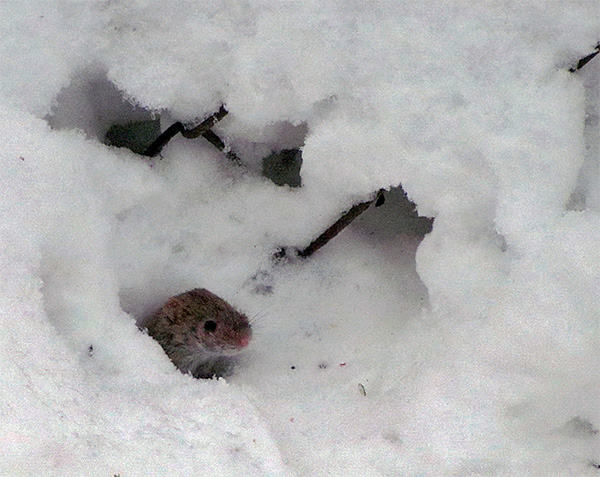
In general, in winter, the need for food for a mole is reduced to some extent. He moves less at this time, does not show sexual activity, does not feed cubs, and due to the hardness of the soil during freezing, he makes fewer new moves and, accordingly, spends less energy. And biorhythms in his body work like clockwork, reducing the need for food.
Should the site be protected from these animals in the winter season?
From the foregoing, it becomes clear that in the garden and in the summer cottage, the mole leads practically the same lifestyle in winter as in the summer - well, except that the animal hardly catches the eye, since its activity largely hides the snow cover.
However, although the harmfulness of the animal is reduced at this time, the animal continues to remain an unwanted guest:
- In winter, the mole continues to destroy useful earthworms (inactive and in suspended animation);
- The animal continues to dig underground tunnels, albeit in smaller volumes and at a reduced speed. In spring, all this activity covered with snow will manifest itself, especially when digging a garden;
- When laying new moves, the mole continues to spoil the planting of vegetables wintering in the open ground - onions, garlic, beets. It also harms flower beds and flower beds.
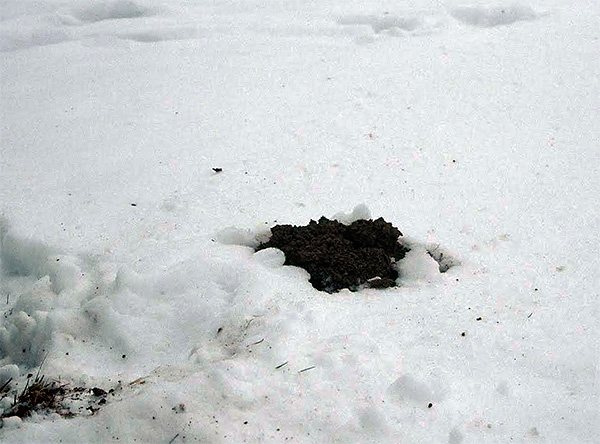
In addition, in winter, moles from neighboring sites can enter the garden in search of food. And if they like it here, then the animals will not fail to settle on a permanent residence.
On a note
In many areas, moles do not appear in winter, but in the second half of autumn. The owners of the plots at this time already have time to harvest and do not notice that zealous diggers have begun to wield underground. In spring, when they discovered passages, molehills, or even damaged beds with wintering crops, many people think that moles appeared here just during the winter - because, it would seem, they weren’t visible even in the fall ...
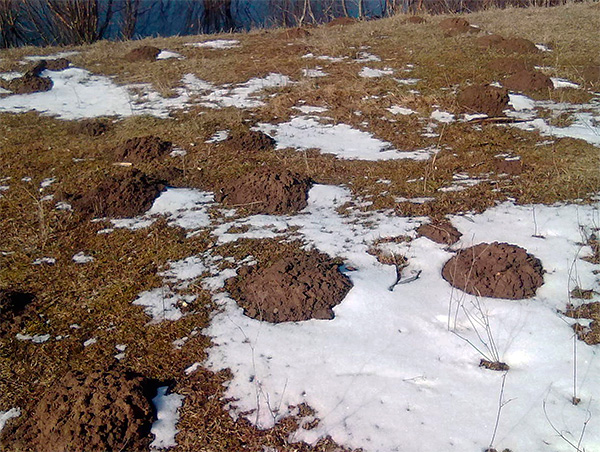
Given all this, mole repellents (both ultrasonic and homemade) should be left on the site for the winter. Other means of protection should also be kept here: anti-mole trenches, a net from moles, hunting glasses.
Do moles sleep at all?
Like other animals, moles sleep to restore strength. Only they do it completely not in the mode that a person is used to, and therefore sometimes it may seem that the mole does not sleep at all.
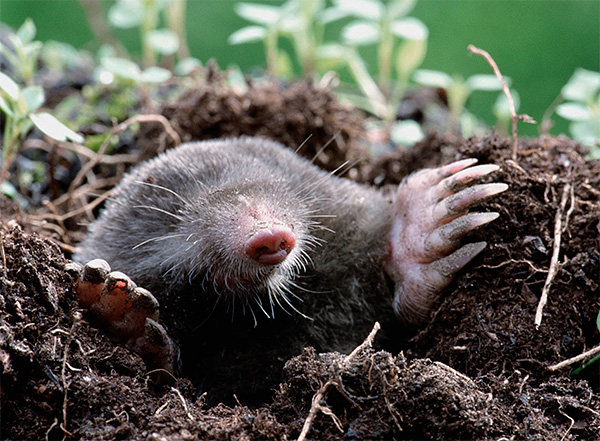
Moles sleep 5-6 times a day for 60-90 minutes. For sleep, the animal usually moves from the feed passages to the nesting chamber, well equipped and insulated, takes care of its hair here, and the female feeds and grows offspring here in the summer.
It is interesting
The mole “goes to bed”, curled up in a ball, like a cat. So it reduces heat loss through the stomach and legs.
The animal does not have a strict daily activity schedule. In his dungeons darkness reigns constantly, and he does not care when to hunt and sleep - at night or in the afternoon.Therefore, the animal, with approximately the same frequency, sleeps, feeds, and digs in the ground at any time of the day.
In general, in winter, the mole sleeps more often and longer than in summer. This allows him to save energy and better recover between energy-intensive work on the device of a new move. But even at this time the animal does not rest for more than 2-3 hours - with his gluttony during this time he manages to get very hungry, and is forced to run away again to his tunnels to look for food.
An interesting video with an example of how a mole searches for food in the snow in winter
An effective way to deal with moles in the area

